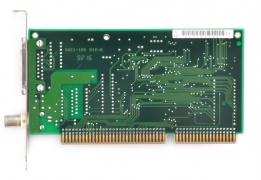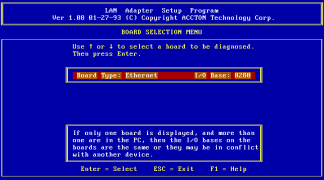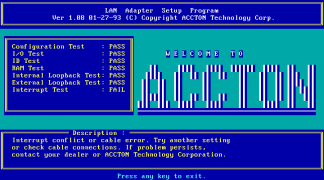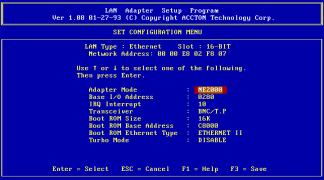Difference between revisions of "Accton EN1640"
Malvineous (talk | contribs) (Update infobox) |
Malvineous (talk | contribs) (Add resources and screenshots) |
||
| Line 23: | Line 23: | ||
<gallery mode="packed"> | <gallery mode="packed"> | ||
Image:Accton EN1640 underside.jpg|Underside | Image:Accton EN1640 underside.jpg|Underside | ||
| + | Image:Accton EN1640 configuration utility.png|Config utility | ||
| + | Image:Accton EN1640 diagnostics.png|Diagnostics | ||
| + | Image:Accton EN1640 configuration options.png|Config options | ||
</gallery> | </gallery> | ||
| Line 30: | Line 33: | ||
The card's DOS drivers come with a configuration program (<tt>DIAG/SETUP.EXE</tt>) that can be used to enable the ROM socket (it is disabled by default) and set the base address, as well as adjust all the usual options like base address and IRQ. | The card's DOS drivers come with a configuration program (<tt>DIAG/SETUP.EXE</tt>) that can be used to enable the ROM socket (it is disabled by default) and set the base address, as well as adjust all the usual options like base address and IRQ. | ||
| + | |||
| + | == Resources == | ||
| + | |||
| + | * I/O address: 0, 20, 40, ... 3A0, 3E0, then the same increments starting at 2000, 4000, 6000, 8000, A000, C000, E000. | ||
| + | * IRQ: 2, 3, 4, 5, 7, 10, 11, 15, Disabled. | ||
| + | * Boot ROM size: 16kB, 32kB, 64kB, Disabled. | ||
| + | * Boot ROM: 8000, 8400, 8800, 8C00, then the same increments starting at 9000, A000, B000, C000, D000, E000 and F000. | ||
== References == | == References == | ||
<references/> | <references/> | ||
Revision as of 21:24, 26 January 2016
The Accton EN1640 is a 10Mbps network card.
Additional photos
Boot ROM
This card's boot ROM socket will take a standard 28-pin ROM chip. It has also been successfully tested with a 32-pin ROM chip using an adapter[1]. XTIDE will run without any problem.
The card's DOS drivers come with a configuration program (DIAG/SETUP.EXE) that can be used to enable the ROM socket (it is disabled by default) and set the base address, as well as adjust all the usual options like base address and IRQ.
Resources
- I/O address: 0, 20, 40, ... 3A0, 3E0, then the same increments starting at 2000, 4000, 6000, 8000, A000, C000, E000.
- IRQ: 2, 3, 4, 5, 7, 10, 11, 15, Disabled.
- Boot ROM size: 16kB, 32kB, 64kB, Disabled.
- Boot ROM: 8000, 8400, 8800, 8C00, then the same increments starting at 9000, A000, B000, C000, D000, E000 and F000.



